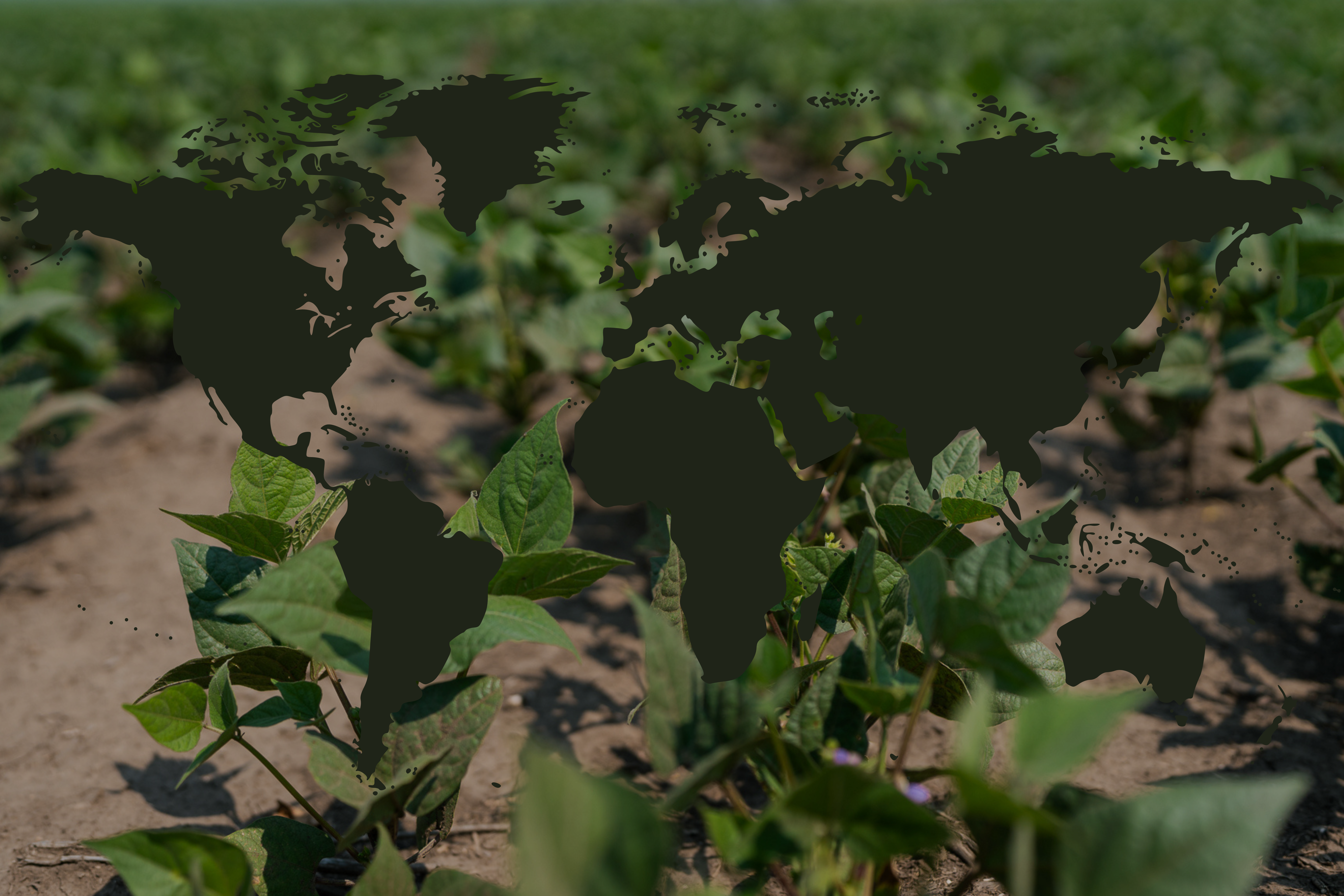By Brian Clancey, STAT Publishing
October 2025
General weakness in global pulse markets is not helping prices for dry edible beans and chickpeas. Though not surprising for chickpeas because of bigger harvests in the United States (U.S.) and Canada, many thought dry beans would fare better due to this year’s drop in forecast production.
Dry Beans
Preliminary forecasts would see Canada’s bean harvest total 351,800 tonnes from 399,700 acres, down from 424,100 tonnes from 402,300 acres last year. At the moment, the U.S. harvest is forecast to drop from 1.542 to 1.455 million tonnes because of a steep drop in seeded area from 1.658 to 1.484 million acres.
Though the combined harvest for the two countries is down 8% from last year at 1.81 million tonnes, it is 6% over the previous five-year average of 1.7 million. Unfortunately, the drop in production is being offset by an increase in the amount of beans carried over from the previous marketing year. For now, this year’s available supply is expected to total 2.409 million tonnes, up from 2.393 million last year.
Pinto beans are the most important class grown in Saskatchewan, Manitoba, and the U.S. Available data suggests the Canadian harvest jumped from around 107,500 tonnes in 2023 to 160,100 last year and could exceed 134,000 this year. Output in the U.S. soared from 390,000 tonnes in 2023 to 607,700 last year before dropping back to an estimated 529,000 tonnes this year.
Recent shifts in production were clearly influenced by Mexican import demand. Purchases from both Canada and the U.S. surged during the 2023/24 marketing year. U.S. shipments soared from 27,600 to 83,100 tonnes, while Canadian movement more than tripled from 7,900 to 30,000 tonnes.
Optimism of continued strong import demand during the past marketing year proved incorrect. Between the 2023/24 and 2024/25 marketing years, U.S. shipments to Mexico sank 58% and Canadian 43%. Some market participants believe this trend will continue through the coming marketing year, citing anecdotal reports Mexican production will be up substantially this year.
Reduced movement to Mexico has resulted in a solid increase in ending stocks. As of July 31, the North Dakota State University’s Upper Great Plains Transportation Institute survey of processors in North Dakota found that pinto bean stocks held by processors jumped from 59,100 tonnes last year to almost 131,000 this year. An argument could be made that Canada ended its 2024/25 marketing year with 38,400 tonnes of pinto beans on hand, up from 30,300 last year.
It is worth noting that markets doubt available data about residual supplies of beans in Canada. The Canadian Grain Commission (CGC) reported that as of July 31 primary elevators had 97,800 tonnes of beans on hand, including 91,400 in Manitoba and 2,600 in Saskatchewan. That is up from 59,300 tonnes last year. Since Agriculture Canada does not believe primary elevators are correctly reporting stocks, their analysts reckon the 2024/25 marketing year ended with 45,000 tonnes of all classes of beans on hand.
The problem for dry edible bean growers is that residual supplies of pinto beans and other classes of colored beans are expected to rise relative to prospective demand. This will make it harder for dark or light red kidney, small red, or great northern beans to escape the underlying price direction for pulses in global markets.
This could be especially true for growers without forward sales contracts with companies which have strong ties with domestic packagers or canners. Many of those companies tend to cover needs several months in advance with suppliers who understand both the delivery schedules and the qualities needed. In turn, many of those suppliers prefer to deal with a short list of trusted growers who understand their needs.
Part of the reason is North American retail prices for dry edible beans are sticky. The last major price increase was during the 2021/22 marketing year. Average retail prices jumped 13% from $1.49 to $1.64 per pound on a year over year basis. During that same period, the weighted average prices for U.S. beans on an freight on board (FOB) shipping point basis jumped 24% from U.S. 41.6 cents per pound in 2020/21 to 51.5 cents in 2021/22.
While the average retail price for dry edible beans in the U.S. has risen 1% since 2021/22, the weighted average price for beans on an FOB shipping point basis fell 16%. Those averaged 42.9 cents per pound last season, and just 36 cents so far this season.
Clearly, prices paid to farmers is not a major factor in the value of beans in North American domestic markets. As a result, falling prices would be expected to have limited impact on consumer purchases. Even though price relationships between beans and other dietary proteins are likely more important, consumers may choose to eat more rice or pasta than substitute beans for a ribeye steak.
Canada-U.S. Edible Bean Situational – October 2025
| 2020 | 2021 | 2022 | 2023 | 2024 | 2024 | 2025 | |
|---|---|---|---|---|---|---|---|
| AREA (ACRES) | |||||||
| Canada | 409,100 | 467,100 | 430,599 | 317,600 | 355,000 | 402,300 | 399,700 |
| United States | 1,342,500 | 1,808,500 | 1,451,500 | 1,295,800 | 1,247,300 | 1,658,000 | 1,483,500 |
| Total | 1,751,600 | 2,275,600 | 1,882,099 | 1,613,400 | 1,602,300 | 2,060,300 | 1,883,200 |
| PRODUCTION (TONNES) | |||||||
| Canada | |||||||
| Coloured | 263,400 | 354,800 | 282,005 | 244,397 | 293,560 | 356,299 | 286,198 |
| White | 88,700 | 144,800 | 88,068 | 88,597 | 82,455 | 67,842 | 65,589 |
| Canadian Total | 352,100 | 499,600 | 370,073 | 332,994 | 376,015 | 424,141 | 351,787 |
| United States | |||||||
| Pinto | 308,582 | 605,915 | 335,208 | 486,437 | 389,776 | 607,684 | 529,300 |
| Black | 229,656 | 297,332 | 208,609 | 270,888 | 304,001 | 417,310 | 339,400 |
| Navy | 135,260 | 206,432 | 158,305 | 163,477 | 145,514 | 119,477 | 149,900 |
| Great Northern | 46,585 | 79,970 | 52,209 | 25,220 | 40,053 | 50,350 | 53,100 |
| Other | 264,152 | 367,626 | 300,344 | 270,992 | 261,216 | 346,940 | 383,631 |
| U.S. Total | 984,235 | 1,557,275 | 1,054,675 | 1,217,014 | 1,140,560 | 1,541,760 | 1,455,331 |
| Total Production | 1,336,335 | 2,056,875 | 1,424,748 | 1,550,008 | 1,516,575 | 1,965,901 | 1,807,118 |
| Opening Stocks | 458,000 | 322,000 | 578,000 | 594,000 | 613,000 | 440,000 | 620,000 |
| Total Supply | 1,794,335 | 2,378,875 | 2,002,748 | 2,144,008 | 2,129,575 | 2,405,901 | 2,427,118 |
| Rolling Average | 1,947,449 | 1,919,057 | 1,992,680 | 2,038,566 | 2,065,262 | 2,089,908 | 2,212,221 |
Based on data from USDA, StatCan, and STAT Publishing.
Chickpeas
Similar to other pulses, chickpeas are also starting the 2025/26 marketing year with lower average prices as processors and exporters ask themselves if they can sell what farmers grew. The situation is not helped by the fact that so far, each production estimate has been larger than the previous.
In its last model-based forecast for the year, Statistics Canada (StatCan) lifted increased its estimate from around 309,000 tonnes in August to 331,000 in September. While up 15% from last year, it is a massive 82% increase over the previous five-year average of roughly 182,200 tonnes. Some market participants expect think a direct survey of farmers could cause StatCan to boost its December estimate to 400,000 tonnes.
Though production was not broken down by class until the final crop report of the year, the latest forecast suggests this year’s desi chickpea harvest jumped from 9,500 to 28,400 tonnes, while our kabuli harvest advanced from 270,300 to 296,200 tonnes
Given a carry over of 62,000 tonnes, Canada’s available supply of chickpeas will climb from 359,100 to 426,000 tonnes. If exports are similar to last year, next summer’s residual stocks could double again to around 127,000 tonnes. Because that outlook suggests the quantity of unsold chickpeas on farms will increase, it is reasonable to expect next year’s plantings to decrease.
The situation is the same in the U.S. This is troubling because we are each, one another’s most important export destinations for chickpeas. Combined production could jump from 545,000 to 694,100 tonnes, while the available supply jumps from 738,700 to 920,100 tonnes. It is above average, but below what was available at the start of the both the 2019/20 and 2020/21 marketing years.
This year’s increases in North American output mirror what is happening in countries like Russia, which has emerged as an important competitor for available demand in Pakistan and other destinations. Global kabuli chickpea production has been trending upward since 2021. It could reach 2.93 million tonnes this year, up from 2.599 million last year and just 1.861 million in 2021. Though prices for the largest caliber of kabuli chickpeas remain strong, values for medium and small caliber have come under pressure. Rising competition between origins for available demand make it difficult for prices for small and medium caliber product to break out of their current ranges.
Global Kabuli Chickpea Supply-Demand Estimates
| 2019 | 2020 | 2021 | 2022 | 2023 | 2024 | 2025 | |
|---|---|---|---|---|---|---|---|
| Area (hectares) | 1,825,000 | 1,586,000 | 1,546,000 | 1,745,000 | 1,777,000 | 2,053,000 | 2,531,000 |
| Yield (kg/ha) | 1,547 | 1,499 | 1,204 | 1,316 | 1,395 | 1,266 | 1,157 |
| Production (tonnes) | 2,824,000 | 2,377,000 | 1,861,000 | 2,296,000 | 2,479,000 | 2,599,000 | 2,928,000 |
| Carry-in (tonnes) | 632,000 | 719,000 | 452,000 | 369,000 | 394,000 | 370,000 | 235,000 |
| Supply (tonnes) | 3,456,000 | 3,096,000 | 2,313,000 | 2,665,000 | 2,873,000 | 2,969,000 | 3,163,000 |
| Trade (tonnes) | 1,116,000 | 1,147,000 | 741,000 | 1,045,000 | 1,308,000 | 1,454,000 | 1,629,000 |
| Inferred Use (tonnes) | 2,737,000 | 2,644,000 | 1,944,000 | 2,271,000 | 2,503,000 | 2,734,000 | 2,775,000 |
| Ending Stock (tonnes) | 719,000 | 452,000 | 369,000 | 394,000 | 370,000 | 235,000 | 388,000 |
| Stock-Use Ratio | 26.27% | 17.10% | 18.98% | 17.35% | 14.78% | 8.60% | 13.98% |
| Per Capita Use (kg) | 0.36 | 0.35 | 0.25 | 0.29 | 0.32 | 0.35 | 0.35 |
Estimates by STAT based data from the FAO, USDA, StatCanada, ABARES, and other entities.
Brian Clancey is the Editor and Publisher of www.statpub.com market news website and President of STAT Publishing Ltd. He can be reached at editor@statpub.com.



